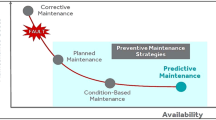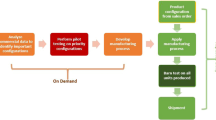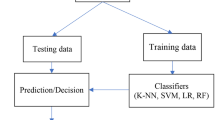Abstract
The reliability estimation of engineered components is fundamental for many optimization policies in a production process. The main goal of this paper is to study how machine learning models can fit this reliability estimation function in comparison with traditional approaches (e.g., Weibull distribution). We use a supervised machine learning approach to predict this reliability in 19 industrial components obtained from real industries. Particularly, four diverse machine learning approaches are implemented: artificial neural networks, support vector machines, random forest, and soft computing methods. We evaluate if there is one approach that outperforms the others when predicting the reliability of all the components, analyze if machine learning models improve their performance in the presence of censored data, and finally, understand the performance impact when the number of available inputs changes. Our experimental results show the high ability of machine learning to predict the component reliability and particularly, random forest, which generally obtains high accuracy and the best results for all the cases. Experimentation confirms that all the models improve their performance when considering censored data. Finally, we show how machine learning models obtain better prediction results with respect to traditional methods when increasing the size of the time-to-failure datasets.
Similar content being viewed by others
References
Birolini A (2007) Reliability engineering, vol 5. Springer, Berlin
Shi H, Zeng J (2016) Real-time prediction of remaining useful life and preventive opportunistic maintenance strategy for multi-component systems considering stochastic dependence. Comput Ind Eng 93:192–204
Luo M, Yan HC, Hu B, Zhou JH, Pang CK (2015) A data-driven two-stage maintenance framework for degradation prediction in semiconductor manufacturing industries. Comput Ind Eng 85:414–422
Sun Y, Ma L, Mathew J (2009) Failure analysis of engineering systems with preventive maintenance and failure interactions. Comput Ind Eng 57(2):539–549
Rodger J A, George JA (2017) Triple bottom line accounting for optimizing natural gas sustainability: a statistical linear programming fuzzy ILOWA optimized sustainment model approach to reducing supply chain global cybersecurity vulnerability through information and communications technology. J Clean Prod 142:1931–1949
Ebeling CE (2010) An introduction to reliability and maintainability engineering. Waveland Press, Long Grove
O’Connor P, Kleyner A (2011) Practical reliability engineering. Wiley, Hoboken
Ahmad R, Kamaruddin S (2012) An overview of time-based and condition-based maintenance in industrial application. Comput Ind Eng 63(1):135–149
Crocker J, Kumar UD (2000) Age-related maintenance versus reliability centred maintenance: a case study on aero-engines. Reliab Eng Syst Saf 67(2):113–118
Manzini R, Regattieri A, Pham H, Ferrari E (2009) Maintenance for industrial systems. Springer Science & Business Media, Berlin
Nakagawa T (2006) Maintenance theory of reliability. Springer Science & Business Media, Berlin
das Chagas Moura M, Zio E, Lins ID, Droguett E (2011) Failure and reliability prediction by support vector machines regression of time series data. Reliab Eng Syst Saf 96(11):1527–1534
Bishop CM (2006) Pattern recognition and machine learning. Springer, Berlin
Witten IH, Frank E (2005) Data mining: practical machine learning tools and techniques, 2nd edn. Morgan Kaufmann, San Francisco
Amjady N, Ehsan M (1999) Evaluation of power systems reliability by an artificial neural network. IEEE Trans Power Syst 14(1):287–292
Chatterjee S, Bandopadhyay S (2012) Reliability estimation using a genetic algorithm-based artificial neural network: an application to a load-haul-dump machine. Expert Syst Appl 39(12):10,943–10,951
Hong WC, Pai PF (2006) Predicting engine reliability by support vector machines. Int J Adv Manuf Technol 28(1–2):154–161
Gokulachandran J, Mohandas K (2015) Comparative study of two soft computing techniques for the prediction of remaining useful life of cutting tools. J Intell Manuf 26(2):255–268
Wu X, Zhu Z, Fan S, Su X (2016) Failure and reliability prediction of engine systems using iterated nonlinear filters based state-space least square support vector machine method. Optik Int J Light Electron Opt 127 (3):1491–1496
Regattieri A, Manzini R, Battini D (2010) Estimating reliability characteristics in the presence of censored data: a case study in a light commercial vehicle manufacturing system. Reliab Eng Syst Saf 95(10):1093–1102
Kumar UD, Crocker J, Knezevic J, El-Haram M (2012) Reliability, maintenance and logistic support: a life cycle approach. Springer, Berlin
Meeker WQ, Escobar LA (1998) Statistical methods for reliability data, vol 314. Wiley-Interscience, Hoboken
Nelson WB (2009) Accelerated testing: statistical models, test plans, and data analysis, vol 344. Wiley, Hoboken
Jardine AK, Tsang AH (2013) Maintenance, replacement, and reliability: theory and applications. CRC Press, Boca Raton
Bontempi G, Taieb SB, Le Borgne YA (2013) Machine learning strategies for time series forecasting. In: Business intelligence. Springer, Berlin, pp 62–77
Vanini ZS, Khorasani K, Meskin N (2014) Fault detection and isolation of a dual spool gas turbine engine using dynamic neural networks and multiple model approach. Inf Sci 259:234–251
Ogaji SO, Singh R (2003) Advanced engine diagnostics using artificial neural networks. Appl Soft Comput 3(3):259–271
Widodo A, Yang BS (2007) Support vector machine in machine condition monitoring and fault diagnosis. Mech Syst Signal Process 21(6):2560–2574
Liu MC, Kuo W, Sastri T (1995) An exploratory study of a neural network approach for reliability data analysis. Qual Reliab Eng Int 11(2):107–112
Alsina EF, Cabri G, Regattieri A (2016) A neural network approach to find the cumulative failure distribution: modeling and experimental evidence. Qual Reliab Eng Int 32(2):167–579
Ho S, Xie M, Goh T (2002) A comparative study of neural network and Box-Jenkins ARIMA modeling in time series prediction. Comput Ind Eng 42(2):371–375
Xu K, Xie M, Tang LC, Ho S (2003) Application of neural networks in forecasting engine systems reliability. Appl Soft Comput 2(4):255–268
Fink O, Zio E, Weidmann U (2014) Predicting component reliability and level of degradation with complex-valued neural networks. Reliab Eng Syst Saf 121:198–206
Lins ID, Moura MdC, Zio E, Droguett EL (2012) A particle swarm-optimized support vector machine for reliability prediction. Qual Reliab Eng Int 28(2):141–158
Chen KY (2007) Forecasting systems reliability based on support vector regression with genetic algorithms. Reliab Eng Syst Saf 92(4):423–432
Pai PF, Lin KP (2006) Application of hybrid learning neural fuzzy systems in reliability prediction. Qual Reliab Eng Int 22(2):199–211
Zadeh LA (1994) Fuzzy logic, neural networks, and soft computing. Commun ACM 37(3):77–84
Draper NR, Smith H (2014) Applied regression analysis. Wiley, Hoboken
Marsland S (2015) Machine learning: an algorithmic perspective. CRC Press, Boca Raton
Jang JSR, Sun CT, Mizutani E (1997) Neuro-fuzzy and soft computing: a computational approach to learning and machine intelligence. Prentice Hall, Upper Saddle Rive
Alzghoul A, Löfstrand M, Backe B (2012) Data stream forecasting for system fault prediction. Comput Ind Eng 62(4):972–978
Rustagi J (1994) Optimization techniques in statistics. Academic Press, Cambridge
Smola AJ, Schölkopf B (2004) A tutorial on support vector regression. Stat Comput 14(3):199–222
Cortes C, Vapnik V (1995) Support vector networks. Mach Learn 20:273–297
Dietterich TG (2000) Ensemble methods in machine learning. In: Multiple classifier systems. Springer, Berlin, pp 1–15
Kuncheva L (2001) Combining classifiers: soft computing solutions. In: Pal S, Pal A (eds) Pattern recognition. From classical to modern approaches. World Scientific, Singapore, pp 427–451
Breiman L (2001) Random forests. Mach Learn 45(1):5–32
Breiman L (1996) Bagging predictors. Mach Learn 24(2):123–140
Haykin S (1998) Neural networks: a comprehensive foundation, 2nd edn. Prentice Hall PTR, NJ
Moller F (1990) A scaled conjugate gradient algorithm for fast supervised learning. Neural Netw 6:525–533
Zadeh LA (1965) Fuzzy sets. Inf Control 8(3):338–353
Yager RR, Filev DP (1994) Essentials of fuzzy modeling and control. Wiley-Interscience, New York
Casillas J, Cordon O, Herrera F, Magdalena L (2003) Interpretability issues in fuzzy modeling. Springer, Berlin
Alonso JM, Magdalena L, González-Rodríguez G (2009) Looking for a good fuzzy system interpretability index: an experimental approach. Int J Approx Reason 51:115–134
Cordón O, Herrera F, Hoffmann F, Magdalena L (2001) Genetic fuzzy systems. Evolutionary tuning and learning of fuzzy knowledge bases. World Scientific, Singapore
Cordón O, Gomide F, Herrera F, Hoffmann F, Magdalena L (2004) Ten years of genetic fuzzy systems: current framework and new trends. Fuzzy Sets Syst 141(1):5–31
Herrera F (2008) Genetic fuzzy systems: taxonomy, current research trends and prospects. Evol Intell 1:27–46
Sánchez L, Couso I, Corrales J (2001) Combining GP operators with SA search to evolve fuzzy rule based classifiers. Inf Sci 136(1-4):175–191
Kirkpatrick S, Gelatt CD, Vecchi MP (1983) Optimization by simulated annealing. Sci 220(4598):671–680
Koza JR (1992) Genetic programming: on the programming of computers by means of natural selection, vol 1. MIT Press, Cambridge
Ferrari E, Pareschi A, Regattieri A, Persona A (2002) TPM: situation and procedure for a soft introduction in Italian factories. TQM Mag 14(6):350–358
Kaplan EL, Meier P (1958) Nonparametric estimation from incomplete observations. J Am Stat Assoc 53(282):457–481
Kohavi R (1995) A study of cross-validation and bootstrap for accuracy estimation and model selection. In: Proceedings of the 14th international joint conference on artificial intelligence, IJCAI’95, vol 2. Morgan Kaufmann Publishers Inc., San Francisco, pp 1137–1143
Alcalá-Fdez J, Sanchez L, Garcia S, del Jesus MJ, Ventura S, Garrell JM, Otero J, Romero C, Bacardit J, Rivas V M et al (2009) Keel: a software tool to assess evolutionary algorithms for data mining problems. Soft Comp 13(3):307–318
Wang ZM, Yang JG (2012) Numerical method for Weibull generalized renewal process and its applications in reliability analysis of nc machine tools. Comput Ind Eng 63(4):1128–1134
Author information
Authors and Affiliations
Corresponding author
Rights and permissions
About this article
Cite this article
Alsina, E.F., Chica, M., Trawiński, K. et al. On the use of machine learning methods to predict component reliability from data-driven industrial case studies. Int J Adv Manuf Technol 94, 2419–2433 (2018). https://doi.org/10.1007/s00170-017-1039-x
Received:
Accepted:
Published:
Issue Date:
DOI: https://doi.org/10.1007/s00170-017-1039-x




